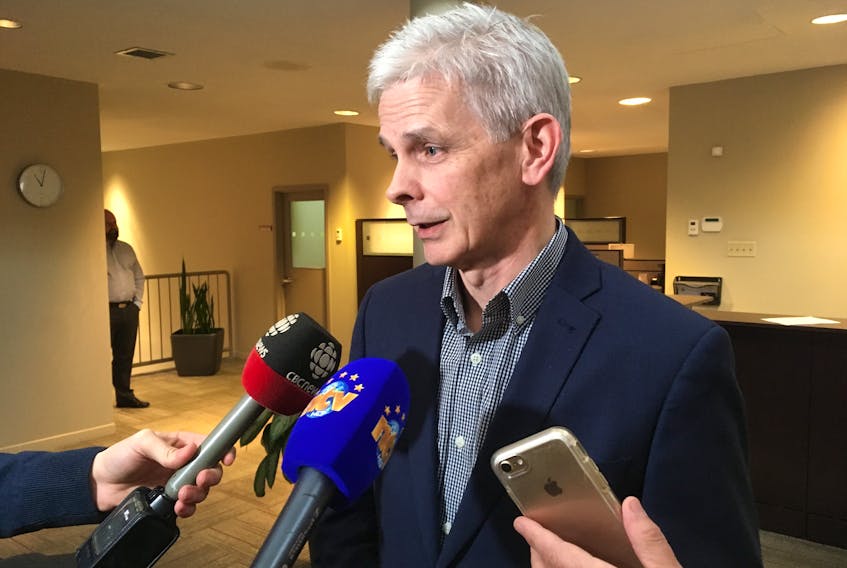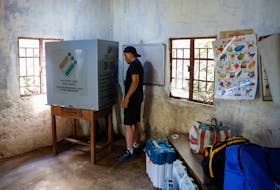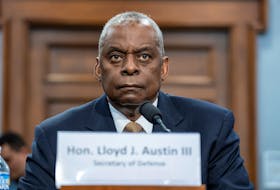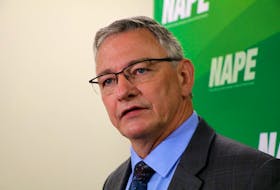There have been recent heated exchanges between provincial Health Minister John Haggie and leaders at the Newfoundland and Labrador Medical Association (NLMA).
The doctors’ association accused the minister of having an agenda to reduce access to family doctors. Through a statement, Haggie suggested it wasn’t what he meant.
The Telegram sought a follow-up interview with the minister, but was declined.
RELATED STORIES:
N.L. doctors fear ‘closed doors’ approach to healthcare reform
Corner Brook doctor disheartened by Health minister’s comments
The exchange of news releases has led to some public debate, even as essential questions remain unanswered.
Among others: how many doctors are there around the province? Is there a ballpark figure on how many family doctors and specialists the province needs?
Hello, neighbour
Doctor counts, including recruitment and retention numbers, are part of the public conversation in Nova Scotia.
Meeting demand was a top question for Nova Scotia Premier Stephen McNeil in year-end media interviews. As the Canadian Press reported in mid-December, a committee of the Nova Scotia legislature was told 42,000 people in that province are without a family physician, with federal statistics coming in higher than that (closer to 100,000), but including people not necessarily seeking a doctor right now.
The expectation in Nova Scotia is that doctor vacancies will persist, given a wave of retirements set to continue through 2021. An estimated 55 per cent of doctors there are older than 50.
According to the Canadian Institute for Health Information (CIHI), the average age of family physicians in Newfoundland and Labrador was 48.5 at the time of a 2016 survey. The average age for specialists was 49.1.
But in Nova Scotia, requirements beyond the wave are also roughly established, through updates made to the provincial physician resource plan — an outlook covering doctor demand through 2025.
Newfoundland and Labrador has the “Strategic Health Workforce Plan 2015-2018,” a document addressing needs broadly, across the sector. At the time of its release in 2015, then-Health critic and now-Justice Minister Andrew Parsons said it was an “empty” plan, with little detailed information applicable to future years, particularly in the way of employment targets.
On the numbers
“If you look at the physician component of (the plan), really all there is in there is a count (for 2015). There’s no effort to look at clinical need out into the future, the different sources of supply, where the gap is, and then link that to a recruitment strategy to fill the gaps,” NLMA executive director Robert Thompson said.
Thompson spoke with The Telegram Friday, offering the current doctor numbers — not projections — available for this province as held by the NLMA, the Canadian Medical Association (CMA) and the Canadian Institute for Health Information (CIHI).
In the interview, he made a comment to the effect Newfoundland and Labrador’s Health minister feels the province could do with fewer doctors, by adding more nurse practitioners.
Thompson acknowledged that may not actually be Haggie’s position, but there was ambiguity in the minister’s recent comments to the CBC, and it remains one interpretation. Thompson said the NLMA has asked for a meeting with the minister, but nothing has been set to date.
On the question of how many doctors the province has, Thompson said there is not one go-to count. Some figures include part-time physicians and locums (essentially fill-ins), while sometimes they are not included.
There is a count of NLMA membership as an alternative, but it includes physician instructors and retired physicians not practicing, as two examples. It isn’t universally accepted when talking about clinical service needs.
When you talk about having enough doctors to cover public demand, a count of physicians per population is also not the best, Thompson said, as it won’t give you their geographic dispersal in relation to population, or deal with unique demands in rural areas.
“There are some communities in this province where it’s been traditionally hard to recruit any doctor at all, or when we recruit there’s so many ongoing vacancies that it’s just not stable. Those are good places to hire nurse practitioners to supplement the health care and, as necessary, refer patients with more complex family practice needs to the nearest family physician,” he said.
The NLMA has been side-by-side with the government for years now in supporting greater use of primary health care teams for family medicine, with groups of highly skilled professionals working collaboratively in one area or another.
Thompson said there is still a lot of work to be done if the province wants to establish these teams as a norm, and do more to meet health care needs where they exist.
Recruitment and retention
From April 1 to mid-December 2017, the Nova Scotia Health Authority recruited 92 doctors and still had 60 or more vacancies at the end of the year, as a result of physician retirements and other issues.
The Telegram sought similar numbers for this province. According to the Department of Health, there are 99 vacancies (39 being general practitioners/family physicians), even after recruitment of 95 doctors in 2017.
As of the last count, from April 2017, the NLMA had 1,271 practising members. The next official count will be done this April, after the deadline for membership dues in mid-February. The Telegram was told the association had 53 practising doctors join and 80 leave the association in 2017.
Differences in numbers continue to challenge the public’s ability to understand what is happening in the Newfoundland and Labrador health care system.
The province is above the national average for physicians practising per capita, but that does not necessarily mean higher costs for physician services — something relevant to upcoming negotiations between the NLMA and the government.
Can’t get no (satisfaction)
Department of Health staff stated recruitment and retention is complex and there have been efforts to improve results for Newfoundland and Labrador through the expansion of the Memorial University of Newfoundland medical school class size (from 60 students to 80), having dedicated recruiter positions in health authorities, and bursaries and bonuses for difficult-to-fill positions.
Rural positions are more likely to be salaried, to guarantee a certain level of income.
But the province is still losing on doctor recruitment to the rest of Canada, Thompson said. International recruits are often quick to move on, and seats in the MUN medical school do not necessarily equal new doctors for Newfoundland and Labrador.
The Canadian Medical Association’s physician workforce survey in 2017 included questions on doctor satisfaction and plans for the next couple of years. The percentage of established doctors from this province who said in response that they were “satisfied” or “very satisfied” with their professional lives was lower than anywhere else in Canada.
Looking ahead, 14.3 per cent of responding doctors in this province said they plan to relocate to another Canadian province or territory within the next couple of years. The only other double-digit response in that category was from Saskatchewan, at 10.3 per cent.
Changing demands
Even if all other factors magically held steady, changing demographics and changing demands for service would result in an overall increasing need for the services provided by general practitioners.
An aging population, with additional public health challenges — such as diabetes rates, obesity, smoking and lack of exercise — is leading to an increasing number of complex cases coming through the doors of the standard family practice.
There are longer periods of time with family doctors for each visit, references to specialists and return visits. The same doctor may see fewer patients per day, without any drop in productivity.
Compared to doctors historically, Thompson said, doctors of today are also more likely to require family time, having child-care responsibilities and other demands, in addition to their work. And more doctors are aware of the personal health benefits of a proper work-life balance — vacation time, not accepting suddenly extended hours on a regular basis, not working through weekends or taking calls at all hours.
Statistics available through the CMA show the work put in by doctors in this province comes in just above the Canadian average, for direct patient care hours per week.
As far as could be determined, the province does not have any across-the-board demand for doctors, but the ongoing supply and demand is unclear.









